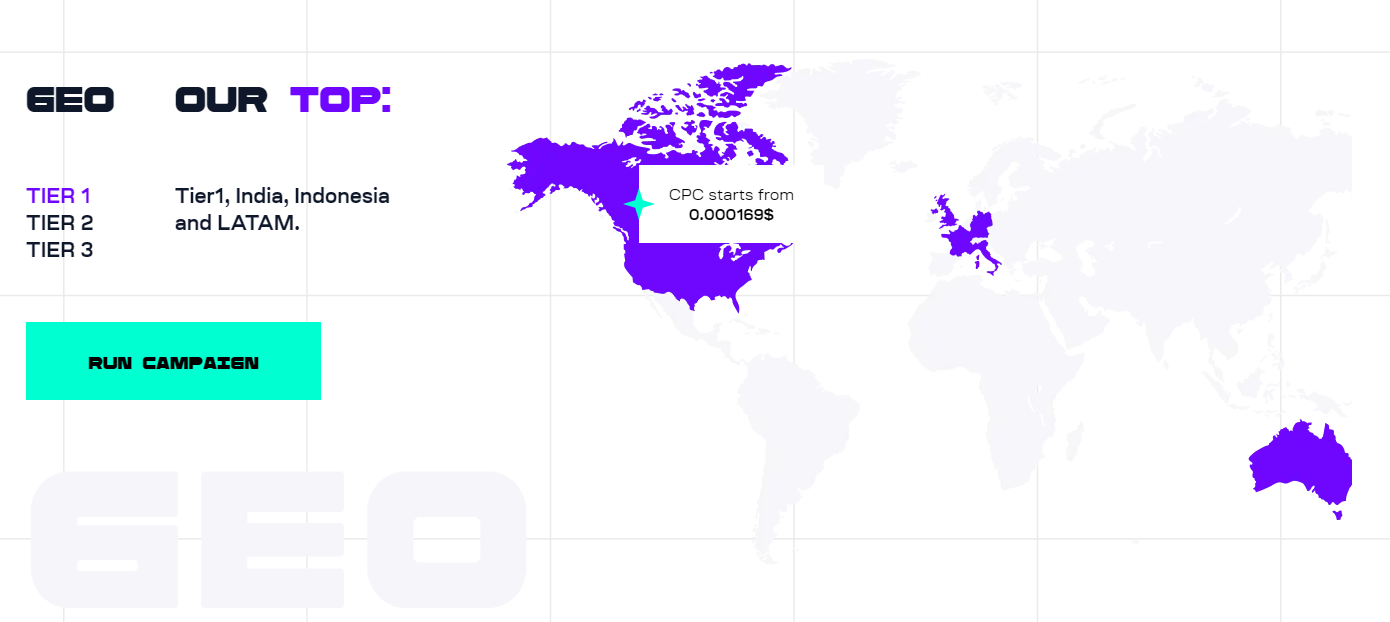When affiliate marketers open an advertising account, they are presented with many performance indicators for their campaigns: conversions, CR, EPC, and more. As they connect trackers, even more metrics become available, making it increasingly challenging to distinguish between important and secondary ones. Each parameter, to some extent, contributes to optimizing traffic and controlling campaign profitability. However, only affiliates who understand the most important metrics and know how to work with them achieve good results.

In this article, we will explore the main metrics in affiliate marketing, using push notifications as an example. We will discuss what these metrics signify, how to calculate them, and their significance in campaign analysis.
How to calculate: CTR = clicks / impressions * 100%
What is the use of the metric: It shows how many people who saw the ad clicked on it. Thanks to this, you can immediately understand whether the creative is suitable for the audience and how willingly users click on the ad.
In the past, marketers would manually calculate the CTR of creatives by using spy services, analyzing different approaches, and tracking test results. However, nowadays, fully managed advertising platforms like MyBid offer personal managers who can assist in selecting potentially high-converting ad creatives even before purchasing traffic. This saves affiliates time and effort, as they can focus on more critical tasks such as finding new offers and negotiating favorable terms with advertisers. With MyBid, affiliates can delegate the task of constantly searching for and preparing new creatives, as the platform automatically rotates and optimizes the images to maintain their effectiveness.
How to calculate: CR = leads / hits to the offer page * 100%
What is the use of the metric: This parameter helps the affiliate understand the effectiveness of the landing page or pre-landing page, as well as the level of user interest in the product. If the conversion rate is low, it indicates that there may be issues with the landing page, such as having too many or too few blocks, which confuses or fails to convince the potential buyer to make a purchase.
Additionally, it could mean that the chosen offer is not appealing to the target audience. A/B testing can be used to identify the specific problem areas. If you are promoting a new product, conducting split tests for 10-14 days can provide valuable insights to draw conclusions and optimize your campaign.

How to calculate: CPC = amount of investment / number of clicks.
What is the use of the metric: CPC allows you to compare different traffic flows within an advertising campaign and determine the most promising ones. It helps you assess the cost-effectiveness of your campaign by calculating how much you are spending for each click received.
Let's consider a scenario: you have prepared two different combinations of creative and landing pages. For the first combination, you invested $100 and received 100 clicks. For the second combination, you also invested $100 but received 200 clicks. In the first case, the CPC is $1, and in the second case, the CPC is $0.5. From this, you can conclude that the second combination is more cost-effective and has the potential for scaling.
How to calculate: EPC = revenue / clicks.
What is the use of the metric: EPC determines the amount of money an affiliate earns from a single click. While some affiliate programs provide the average EPC of a product in the offer card, it's important to note that each affiliate's actual EPC may vary. If two affiliates promote the same product but from different traffic sources, their earnings per click will differ. Additionally, some affiliate programs may manipulate EPCs for less popular offers to attract affiliates.
How to calculate: CPA = amount of investments / leads.
What is the use of the metric: CPA allows affiliates to evaluate the effectiveness of their advertising campaigns by dividing the amount of investment by the number of leads generated. It helps determine the cost associated with each desired action, such as a sale or lead acquisition. For example, if an affiliate pays $10 for each lead generated and earns $50 in revenue from that lead, the campaign will be profitable, assuming it generates a sufficient number of leads.
How to calculate: ROI = (return of investment - volume of investment) / volume of investment * 100%.
What is the use of the metric: ROI is a metric that directly indicates the profitability of an affiliate's investments and whether they are yielding a return. It measures the percentage of return on the investment made.
Here's a simple example to illustrate:

In most paid traffic formats, it is believed that the cost of a click depends on the click-through rate (CTR). In other words, the higher the CTR, the more expensive the click tends to be. However, the push notifications format is considered a cost-effective option that can provide a return on investment (ROI) of over 100% without requiring a huge investment.
The reason for this is that push notifications do not undergo strict creative moderation, and they have a low cost per click, even in Tier-1 countries. In the case of MyBid, the cost of a click from Tier-1 countries ranges from $0.000169. This means that you can reach a premium audience at a relatively low price. Additionally, if the advertiser has any questions about the traffic, you can provide a report to address their concerns.

How to calculate: Landing Page CTR is calculated by dividing the number of visits to the landing page by the number of visits to the pre-landing page and multiplying the result by 100%.
What is the use of the metric: Landing Page CTR reflects the effectiveness and attractiveness of the pre-landing page in capturing the audience's interest and motivating them to proceed to the main landing page. This metric is particularly important in expensive niches like finance, crypto, or nutra, where acquiring conversions can be costly.
By analyzing the Landing Page CTR, affiliates can identify potential issues and optimize their pre-landing page to improve the conversion funnel. It helps affiliates understand at which stage potential leads are dropping off, allowing them to identify and address any obstacles or barriers preventing users from reaching the main landing page.
For example, let's assume an affiliate collected 100 clicks on the pre-landing page, but only 13 of those visitors proceeded to the landing page. In this case, the Landing Page CTR would be calculated as 13 / 100 * 100 = 13%. This indicates that only 13% of the visitors from the pre-landing page successfully reached the main landing page. By monitoring and improving this metric, affiliates can save money by optimizing their campaigns and ensuring a higher percentage of visitors reach the offer page.
Although they may seem similar, they actually measure different aspects of the customer journey.

How to calculate: Click2Reg is calculated by dividing the number of registrations by the number of clicks on the ad and multiplying the result by 100%.
What is the use of the metric: Click2Reg helps assess how effective an advertisement or campaign is in driving registrations. It provides insights into the proportion of users who clicked on the ad and then completed the registration process. This metric is commonly used in industries such as gambling and betting.
How to calculate: Reg2Dep is calculated by dividing the number of first deposits (FDs) by the number of registrations and multiplying the result by 100%.
What is the use of the metric: Reg2Dep helps evaluate the quality of the traffic source and the effectiveness of the registration process. It indicates the percentage of registered users who take the next step of making a deposit, which is an important milestone in the customer journey. Advertisers can use this metric to assess the viability of further cooperation with the traffic source, while affiliates can evaluate the performance of the platform or resource from which they drive traffic.
How to calculate: Inst2Reg is calculated by dividing the number of registrations by the number of mobile app downloads and multiplying the result by 100%.
What is the use of the metric: Inst2Reg provides insights into the quality of the platforms or sources from which the audience originates. It helps evaluate how many users who installed a mobile app went on to complete the registration process. Similar to Reg2Dep, Inst2Reg is used to assess the performance and quality of traffic sources and platforms in terms of their ability to drive registrations.
When working with an affiliate program that provides specific metrics, it's important to understand the calculation method they use. Inexperienced managers may sometimes confuse metrics like EPC (earnings per click) and EPL (earnings per lead). EPC considers clicks, while EPL focuses on leads. Clarifying the calculation method ensures you have accurate information for analysis and decision-making.
It's crucial to remember that all these metrics are subjective depending on your campaign situation and should not be treated as absolute truth. They serve as indicators and should be used as guidelines rather than definitive measures. At MyBid, your personal manager will help you not to get confused in these numbers.
In this article, we will explore the main metrics in affiliate marketing, using push notifications as an example. We will discuss what these metrics signify, how to calculate them, and their significance in campaign analysis.
Basic metrics in affiliate marketing
Let's take a closer look at the fundamental metrics used in affiliate marketing campaigns. These metrics provide valuable insights into the performance and effectiveness of your advertising campaigns. We will discuss the following metrics: Click-through rate (CTR), Conversion rate (CR), Cost per click (CPC), Earnings per click (EPC), Cost per action (CPA), Return on investment (ROI), and Penetration. Additionally, we will briefly touch upon niche indicators that are not commonly found in all campaigns: Click2Reg, Reg2Dep, and Inst2Reg.CTR
What it means: Click-Through Rate or Ad Click-Through RateHow to calculate: CTR = clicks / impressions * 100%
What is the use of the metric: It shows how many people who saw the ad clicked on it. Thanks to this, you can immediately understand whether the creative is suitable for the audience and how willingly users click on the ad.
In the past, marketers would manually calculate the CTR of creatives by using spy services, analyzing different approaches, and tracking test results. However, nowadays, fully managed advertising platforms like MyBid offer personal managers who can assist in selecting potentially high-converting ad creatives even before purchasing traffic. This saves affiliates time and effort, as they can focus on more critical tasks such as finding new offers and negotiating favorable terms with advertisers. With MyBid, affiliates can delegate the task of constantly searching for and preparing new creatives, as the platform automatically rotates and optimizes the images to maintain their effectiveness.
CR
What it means: Conversion RateHow to calculate: CR = leads / hits to the offer page * 100%
What is the use of the metric: This parameter helps the affiliate understand the effectiveness of the landing page or pre-landing page, as well as the level of user interest in the product. If the conversion rate is low, it indicates that there may be issues with the landing page, such as having too many or too few blocks, which confuses or fails to convince the potential buyer to make a purchase.
Additionally, it could mean that the chosen offer is not appealing to the target audience. A/B testing can be used to identify the specific problem areas. If you are promoting a new product, conducting split tests for 10-14 days can provide valuable insights to draw conclusions and optimize your campaign.
CPC
What it means: Cost Per ClickHow to calculate: CPC = amount of investment / number of clicks.
What is the use of the metric: CPC allows you to compare different traffic flows within an advertising campaign and determine the most promising ones. It helps you assess the cost-effectiveness of your campaign by calculating how much you are spending for each click received.
Let's consider a scenario: you have prepared two different combinations of creative and landing pages. For the first combination, you invested $100 and received 100 clicks. For the second combination, you also invested $100 but received 200 clicks. In the first case, the CPC is $1, and in the second case, the CPC is $0.5. From this, you can conclude that the second combination is more cost-effective and has the potential for scaling.
EPC
What it means: Earning Per ClickHow to calculate: EPC = revenue / clicks.
What is the use of the metric: EPC determines the amount of money an affiliate earns from a single click. While some affiliate programs provide the average EPC of a product in the offer card, it's important to note that each affiliate's actual EPC may vary. If two affiliates promote the same product but from different traffic sources, their earnings per click will differ. Additionally, some affiliate programs may manipulate EPCs for less popular offers to attract affiliates.
CPA
What it means: cost per action or the cost of the target action.How to calculate: CPA = amount of investments / leads.
What is the use of the metric: CPA allows affiliates to evaluate the effectiveness of their advertising campaigns by dividing the amount of investment by the number of leads generated. It helps determine the cost associated with each desired action, such as a sale or lead acquisition. For example, if an affiliate pays $10 for each lead generated and earns $50 in revenue from that lead, the campaign will be profitable, assuming it generates a sufficient number of leads.
ROI
What it means: Return On InvestmentHow to calculate: ROI = (return of investment - volume of investment) / volume of investment * 100%.
What is the use of the metric: ROI is a metric that directly indicates the profitability of an affiliate's investments and whether they are yielding a return. It measures the percentage of return on the investment made.
Here's a simple example to illustrate:
- Invested $100. ROI = 0%. The affiliate broke even, recapturing the investment but not making any profit.
- Invested $100. ROI = 50%. The affiliate earned $150, recouping the initial $100 investment and making an additional $50 in profit.
- Invested $100. ROI = 100%. The affiliate received $200 in total, which includes the initial $100 investment and an additional $100 profit.
In most paid traffic formats, it is believed that the cost of a click depends on the click-through rate (CTR). In other words, the higher the CTR, the more expensive the click tends to be. However, the push notifications format is considered a cost-effective option that can provide a return on investment (ROI) of over 100% without requiring a huge investment.
The reason for this is that push notifications do not undergo strict creative moderation, and they have a low cost per click, even in Tier-1 countries. In the case of MyBid, the cost of a click from Tier-1 countries ranges from $0.000169. This means that you can reach a premium audience at a relatively low price. Additionally, if the advertiser has any questions about the traffic, you can provide a report to address their concerns.
Landing Page CTR
What it means: Landing Page CTR refers to the percentage of visitors who click through from a pre-landing page to the main landing page.How to calculate: Landing Page CTR is calculated by dividing the number of visits to the landing page by the number of visits to the pre-landing page and multiplying the result by 100%.
What is the use of the metric: Landing Page CTR reflects the effectiveness and attractiveness of the pre-landing page in capturing the audience's interest and motivating them to proceed to the main landing page. This metric is particularly important in expensive niches like finance, crypto, or nutra, where acquiring conversions can be costly.
By analyzing the Landing Page CTR, affiliates can identify potential issues and optimize their pre-landing page to improve the conversion funnel. It helps affiliates understand at which stage potential leads are dropping off, allowing them to identify and address any obstacles or barriers preventing users from reaching the main landing page.
For example, let's assume an affiliate collected 100 clicks on the pre-landing page, but only 13 of those visitors proceeded to the landing page. In this case, the Landing Page CTR would be calculated as 13 / 100 * 100 = 13%. This indicates that only 13% of the visitors from the pre-landing page successfully reached the main landing page. By monitoring and improving this metric, affiliates can save money by optimizing their campaigns and ensuring a higher percentage of visitors reach the offer page.
Niche metrics
Niche metrics are specific performance indicators that are commonly used in the gambling, betting, and crypto niches. Some of the most popular niche metrics include Click2Reg, Reg2Dep, and Inst2Reg.Although they may seem similar, they actually measure different aspects of the customer journey.
Click2Reg
What it means: Click2Reg refers to the click-to-registration conversion rate, which measures the percentage of clicks on an advertisement that result in registrations.How to calculate: Click2Reg is calculated by dividing the number of registrations by the number of clicks on the ad and multiplying the result by 100%.
What is the use of the metric: Click2Reg helps assess how effective an advertisement or campaign is in driving registrations. It provides insights into the proportion of users who clicked on the ad and then completed the registration process. This metric is commonly used in industries such as gambling and betting.
Reg2Dep
What it means: Reg2Dep stands for registration-to-deposit conversion rate and measures the percentage of registered users who make a deposit.How to calculate: Reg2Dep is calculated by dividing the number of first deposits (FDs) by the number of registrations and multiplying the result by 100%.
What is the use of the metric: Reg2Dep helps evaluate the quality of the traffic source and the effectiveness of the registration process. It indicates the percentage of registered users who take the next step of making a deposit, which is an important milestone in the customer journey. Advertisers can use this metric to assess the viability of further cooperation with the traffic source, while affiliates can evaluate the performance of the platform or resource from which they drive traffic.
Inst2Reg
What it means: Inst2Reg refers to the installation-to-registration conversion rate, which measures the percentage of mobile app installations that result in registrations.How to calculate: Inst2Reg is calculated by dividing the number of registrations by the number of mobile app downloads and multiplying the result by 100%.
What is the use of the metric: Inst2Reg provides insights into the quality of the platforms or sources from which the audience originates. It helps evaluate how many users who installed a mobile app went on to complete the registration process. Similar to Reg2Dep, Inst2Reg is used to assess the performance and quality of traffic sources and platforms in terms of their ability to drive registrations.
Conclusions
You don't have to manually calculate all the metrics yourself. There are online metrics calculators available that can do the job for you. Using such calculators saves time and allows you to focus more on making optimization decisions.When working with an affiliate program that provides specific metrics, it's important to understand the calculation method they use. Inexperienced managers may sometimes confuse metrics like EPC (earnings per click) and EPL (earnings per lead). EPC considers clicks, while EPL focuses on leads. Clarifying the calculation method ensures you have accurate information for analysis and decision-making.
It's crucial to remember that all these metrics are subjective depending on your campaign situation and should not be treated as absolute truth. They serve as indicators and should be used as guidelines rather than definitive measures. At MyBid, your personal manager will help you not to get confused in these numbers.





